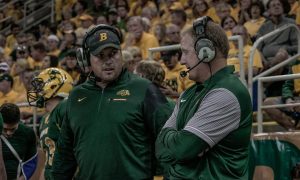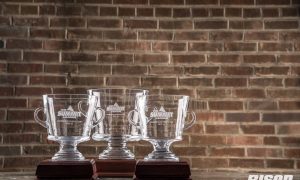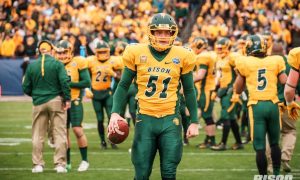Photos by J. Alan Paul
Matt Larsen has made it three-fourths of the way through his first calendar year as director of athletics at NDSU; although the East Coast accent has begun to fade, NDSU’s on-the-field success hasn’t. Coming from Stony Brook, where the athletic program took home three conference championships last year, to Fargo, where the Bison have churned out seven more conference titles and another national championship, is a huge leap. Larsen has found his way into a special program, but he isn’t satisfied with where it’s at yet.
*This is the extended interview from the June 2015 issue of Bison Illustrated magazine. Questions and quotes have been edited for clarity.
The Interview
Bison Illustrated: You survived your first North Dakota winter. How did that go for you?
Matt Larsen: From all the stories I heard I think we had a pretty mild winter so if I could’ve picked the perfect North Dakota winter to move here this was the one. I think I also saw just a great community and I think they embrace the winters around here. It’s like a badge of honor they wear here.
BI: The whole family is here and you’re all settled in?
ML: We closed on our house the Wednesday after the national championship game and the following week my family moved out here, so they’ve been out here just a little over three months. They’re fully settled. Love our neighborhood – we live out in West Fargo – love our house, the kids are getting adjusted in school, and they’re making friends. Things are becoming routine and we’re starting to focus on things we need to start focusing on.
BI: What’s something you’ve learned about Fargo after being planted here for eight months now?
ML: One of the things I noticed and didn’t understand coming in is that Bison athletics is a culture within our fan base; it’s a lifestyle. It’s not just about coming to the game and watching the players; it’s a lifestyle. People plan their vacations around Bison events; it’s generational. We have grandparents and grandsons, grandmothers and granddaughters who come to games together. It’s more than just a fan base, it’s a lifestyle and I guess that’s the biggest thing I didn’t realize coming into it and that’s why we have a passionate fan base.
I would say the things is, and in some senses it’s unique, but in a lot of cases it isn’t because there’s been a fair amount of people who’ve said this and the people I’ve gotten a chance to meet, they say, “We’re so glad you’re here.” I think it just says a lot about the buy-in with our fan base and the excitement around the program where they’re genuinely happy to have me here and to be a part of the program and that means a lot.
BI: Run into any superfans?
ML: That part has been interesting and I think some of our student-athletes see it and our coaches see it, where there’s a little bit of a celebrity status. I think the people involved in Bison athletics which is a good thing and it means people care. They care and they’re interested. I’ll see people in stores come up and say “Hey, great win this weekend.” Or ask me what’s going on with so and so. or “How’s this athlete doing? How’s this year’s recruiting class? What do we look like for next year?” And again, it’s because they care and they’re passionate about it. Those are all great things. If my family and I are out at a restaurant and people come up and want to say hello and see how things are doing, those are the things that are very welcoming. My favorite restaurant and I’ve probably only been there the most as much as any restaurant and we don’t get to go out a whole lot and as much as we’d like with busy schedules and getting the kids transitioned, but Mezzaluna I really like a lot. Good food, good atmosphere, I really like the downtown area. We had our Green & Gold Gala down there this year, really more so because I think with downtown and what it represents and what it means to the University and what it means to this city, is a unique environment and there’s been an influx of people wanting to revitalize it. When people come to visit, I always tell them to come downtown and we go check it out.
BI: What’s the plan with Lynn Dorn’s old position? Will the responsibilities be split among the group you already have?
ML: We’re currently recruiting for a deputy director of athletics position which is going to take on some of the roles that Lynn served. But one of the unique things and one of the great things about Lynn is, Lynn had her primary responsibilities, but Lynn would also take on a lot of things just to make sure things got done and that’s what one of those things that was so great about her. Being able to hire a position that will help supervise some sports and help manage the day-to-day operations and being another member of our senior staff and help us from a vision and strategy, and some of those things.
BI: How do you analyze the possibility of implementing full cost-of-attendance?
ML: I think there are two components for cost-of-attendance. There’s the philosophical piece and there’s the financial piece. I think philosophically, in athletics, we believe in providing the support for our student-athletes. There are a lot of demands on our student-athletes from time commitments to academically, athletically, community service, so for them to be able to go and get a job to support some of the things that they need can be really difficult. So, philosophically being able to provide some aid to help support those expenses that I believe in. Then financially, it’s one of those things where there’s a dollar figure to it. But I also think in promoting it to our constituents and our fan base and them understanding that for us to be able to recruit the best and the brightest and put us in a position to win championships that these are some of the things that we’re going to be able to do. So we’re going to need to rely on our supporters to help us and generate some revenue if we do this.
BI: We’ve seen Boise State plan to spend $1.18 million to implement full cost-of-attendance funding for all its scholarships and we’ve seen Colorado State go as low as $654,000. If NDSU were to hypothetically implement full cost-of-attendance, how much would it cost?
ML: It’s probably somewhere around $700,000 a year if we did it across the board. And I think when you look at our program we see our program as having the opportunity to being the best FCS athletic program in the country and there are a lot of our programs that just don’t compete in the Summit League and Missouri Valley, we compete nationally and to be able to compete nationally that means you’re competing against FBS conferences and large FBS conferences and lower FBS conferences and a lot of those programs are doing cost-of-attendance.
BI: So the Summit League and Missouri Valley are telling NDSU to do whatever it wants when it comes to having cost-of-attendance or not?
ML: I think that’s exactly it. Both the Summit League and the Missouri Valley Football Conference, it’s going to be left up to each of the institution’s discretion because there are so many variables that go into cost-of-attendance whether it’s by sport, individual; I think they’re going to leave it up to each institution on what they see as the best fit for their institution and what they can do financially.
BI: Has the University of North Dakota choosing to implement cost-of-attendance for its hockey programs put any pressure on you to follow?
ML: It hasn’t. We always evaluate what’s best for North Dakota State and the one thing I would say is, and the one thing I think we do a very good job of here throughout our history is treating our athletes as equals, whether you’re the football player or the baseball player, softball athlete, the golf athlete. I think we’ve treated them all equally and so that’s going into our consideration as we look at the best model for cost-of-attendance if we opt to implement it.
BI: How’s the Sanford Health Athletic Complex construction coming along?
ML: Everything is on time as of right now. We’re really looking to see if we can open up the basketball practice facility and the basketball locker rooms for this fall which I think will take some of the stress and pressure off the men’s and women’s basketball programs, but also some of the other facilities where we’ve been trying to get them practice times.
I was in there with one of our employees who’s been here for 15 years and we were walking through there about a week ago and when we were done with the tour he said, ‘it doesn’t look like the old BSA anymore. I don’t recognize it.’ And I think it’s really true. When you walk in there now, you see all the new areas, all the new construction and it’s going to be a transformational facility. We were down at the architects office yesterday picking out some of the final finishes, tiling, cabinetry and those types of things and it’s going to be a first-class facility when it’s done.
The thing I’m most looking forward to is the look on our student athletes faces when they walk in there for the first time. They have a team room that’s just there’s, they have a locker room that’s just there’s, they have practice facilities or weight room that’s division I, and for them to be able to train in the best, I think, will translate onto the court. To be able to see it through their eyes is really exciting.
BI: What’s some of the reaction you’ve received from your peers across the country about the new facility?
ML: I think it’s one of those things that can separate you and set you apart from other places in building these new facilities. Anytime I think there’s construction on campus, it shows growth, it shows progress and it shows vision. So for us, when you add the SHAC back into the other facilities we have here, I think you can very much argue that we have some of the better FCS facilities when you look at it as a whole. That doesn’t mean we’re done. We still have some work to do, but I think when you talk about what that facility is going to have I think people are excited about it but they’re also taking notice of it saying, “Wow North Dakota State is adding that too now?”
BI: Seven more conference championships this year; what’s it going to take to keep the ball rolling?
ML: I just think the expectations from our coaches to our student athletes, it’s the mindset that we’re doing this for one reason and that’s to win a championship. So I think that’s the mindset going in and I think championships are contagious. … That’s why and I’ve said this all along when you’re winning, that’s the time to invest. It’s not time when you’re not winning, because the one thing I think we’ve seen in both the other leagues we compete in, because of our success, people are investing more into their programs to try and narrow the gaps and catch North Dakota State and so that’s why it’s even more important that we continue to invest. Whether it’s our facilities, whether it’s in our operations or being competitive with our coaches’ salaries, we have to continue to invest to make sure we stay on top.










